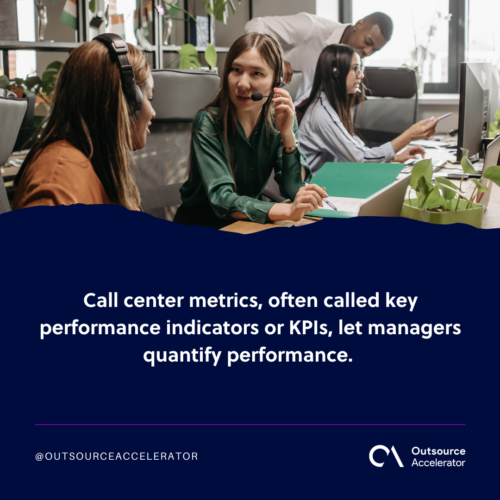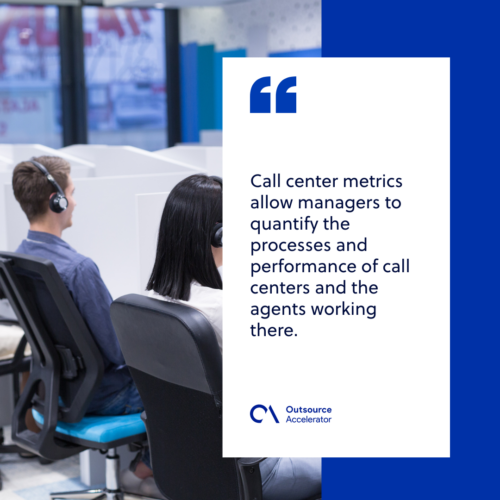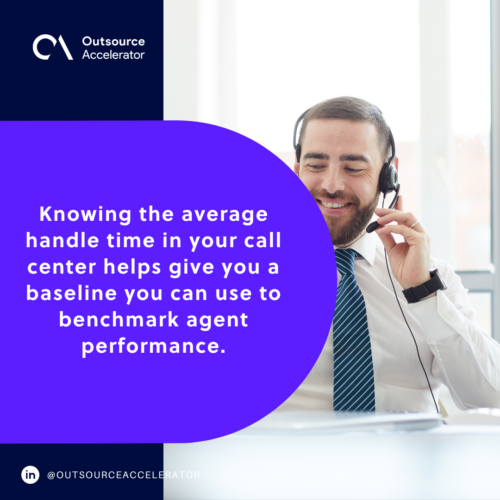10 call center metrics you should keep an eye on in 2025

In today’s fast-paced and dynamic business landscape, companies must constantly improve to remain competitive. This is especially true in the highly aggressive business process outsourcing (BPO), particularly in call centers.
Integrating modern business solutions to call center operations has significantly helped call centers improve their services. These new technologies have improved call center services, allowing them to measure their performance efficiently.
Using call center metrics, call centers gain an effective way of gauging:
- How well are their agents performing?
- How satisfied are their customers?
- Which processes do they need to work on?
These metrics play a vital role in ensuring that call centers remain ahead of their competitors in terms of service quality.
What are call center metrics?
Call center metrics, often called key performance indicators or KPIs, let managers quantify performance. KPIs help call centers to know if they’re reaching their target goals and delivering high-quality services.
Call centers use specific measurements as metrics in their processes. For example, call center metrics can measure:
- The number of calls an agent handles
- How often these calls are escalated
- How long it takes agents to go through a call
Not every BPO firm uses the same set of call center metrics. However, there are some widely-used call center metrics that are often staples in the industry and are used to benchmark performance.
These call center metrics include first contact resolution (FCR), abandonment rate, and service level.

Key areas that call center metrics should cover
For call centers that want to leverage KPIs to improve their services,[1] there are four primary areas they should focus on:
Customer experience
The customer experience (CX) is among the most important aspects of any business. As call centers deal with their clients’ customers, it’s vital that they provide the best customer experience to avoid damaging their clients’ reputations.
Using call center metrics, call center managers can pinpoint the areas of improvement in their processes. For example, if their KPIs show an alarming abandonment rate, they can focus training on that area.
Agent productivity
Managers can also track the productivity of agents using call center metrics. They can see the volume of calls each agent handles daily and how long each call takes.
They can also use these metrics to measure the call completion rate (CCR) of agents.
Call initiation
Call initiation spans the crucial period between a call center’s customer contact with an agent and the initiation of the call.
Overly long waiting times can turn away customers and leave an impression that the call center doesn’t care about its clients. Likewise, constantly getting busy lines when calling is a turnoff for customers.
In a way, call initiation is associated with customer experience because it can affect how callers perceive or feel about a call center’s services.[2]
Call center operations
Call center operations metrics measure the performance of in-call. These measures may include everything from cost per call (CPC) and average call length to repeat calls and the number of calls handled.
These metrics quantify a call center’s performance over periods of time. Using these KPIs, call centers can:
- Predict future staff needs
- Assess which processes are causing operational bottlenecks
- Identify trends
- Manage team workloads and expectations
Why should you care about call center metrics?
As the quote often attributed to Peter Drucker goes, “You can’t improve what you don’t measure.” This line couldn’t be more true for call centers.
Call center metrics allow managers to quantify the processes and performance of call centers and the agents working there. They can then use the data gathered from these metrics to assess their overall performance.
Managers can quickly see whether they’re hitting business goals and which processes are the weakest links in their operations.
Using KPIs helps call center managers to gauge the effectiveness of their customer service teams. Further, these metrics provide them with insights they can use to develop targeted training programs.
In short, using call center metrics helps improve the effectiveness and efficiency of call center operations. It allows managers to accurately measure the performance of agents and the call center as a whole.

10 essential call center metrics you should be watching
Here are ten of the most important call center metrics you should focus on if you want to improve your call center operations.
1. Call arrival rate
Call arrival rate refers to the frequency of inbound calls within a given period. This metric helps managers determine the peak hours of operations and identify seasonal trends.
Knowing the peak hours and call trends will help you manage agent workloads better and hire staff more efficiently during peak seasons.
2. Average call abandonment rate
The average call abandonment rate is a metric pertaining to the number of inbound calls abandoned before getting connected to an agent. This is one metric you’d want to keep as low as possible.
Getting high average call abandonment rates signals a problem in your call center. It may be poor agent performance, understaffing, lack of sufficient technologies, or a combination of these factors.
3. First response time (FRT)
The first response time is the average time it takes before inbound calls are connected to agents. Ideal FRT varies per industry. However, keeping your FRT short is a good practice as it helps improve customer satisfaction.
4. Percentage of calls blocked
This KPI pertains to the percentile amount of inbound callers that end up getting a busy tone. In short, these are the calling customers who cannot reach your call center.
Like the average call abandonment rate, a high percentage of calls blocked means you may need to adjust staffing, increase agents’ productivity, or upgrade your current technologies.
5. Average handle time (AHT)
The average handle time refers to how long an agent takes to help inbound-calling customers. Measuring AHT can also vary per call center.
One call center may measure AHT as soon as a caller connects and until they disconnect. Another may include the time it takes to finish post-call tasks (e.g., filing forms and updating CRMs) in the computation of the AHT.
Knowing the average handle time in your call center helps give you a baseline you can use to benchmark agent performance.

6. Agent utilization rate
Agent utilization rate is like a more detailed version of the AHT. Instead of just looking at the time it takes agents to wrap up calls, it measures everything an agent does from the beginning to the end of their shifts.
Like the other call center metrics, this KPI varies per industry. You’ll likely have to monitor this metric over time to establish an ideal and realistic agent utilization rate.
7. Cost per call
CPC, as its name implies, lets you know how much each call costs you on average. To get the cost per call, divide the total cost of all your calls (including labor costs, general expenses, etc.) by the total number of calls.
Your ideal CPC depends on the size of your call center, the complexity of your processes, and the nature of your business. However, a high CPC generally indicates inefficiency in one or more of your processes.
8. Customer satisfaction score (CSAT)
CSAT measures how satisfied your customers are with your call center services. You can compute your call center’s CSAT using simple surveys your agents can give out to calling customers.
There are no standard ways of measuring CSAT. What matters is for you to devise a way to gauge the satisfaction ratings of your customers and determine the areas where you may need to improve.
9. Customer effort score (CES)
This metric pertains to how easy (or hard) customers can reach resolutions for their problems.
Getting your CES is similar to getting the CSAT. You can have agents ask calling customers how they’d easy it had been to solve their issues.
The question is usually along the lines of “On a scale of one to five, one being extremely difficult and five being really easy, how easy was it to handle your problem?”
A high CES means your customers find it easy to work with your agents.
10. Net promoter score (NPS)
Similar to CSAT and CES, the net promoter score is a metric that measures your customer’s satisfaction with your call center services.
NPS refers to the likelihood that your customers would recommend your call center to other people. A high NPS signifies a positive relationship with your customers.
References
[1] leverage KPIs to improve their performance. M. Plaza and L. Pawlik. (2021). “Influence of the contact center systems development on key performance indicators.” IEEE Access, vol. 9, pp. 44580-44591. doi: 10.1109/ACCESS.2021.3066801
[2] how callers perceive or feel about a call center’s services. Chicu, D. del mar Pamies, M. Ryan, G. Cross, C. (2019). “Exploring the influence of the human factor on customer satisfaction in call centres.” Business Research Quarterly, 22(2), pp. 83-95. https://doi.org/10.1016/j.brq.2018.08.004







 Independent
Independent




